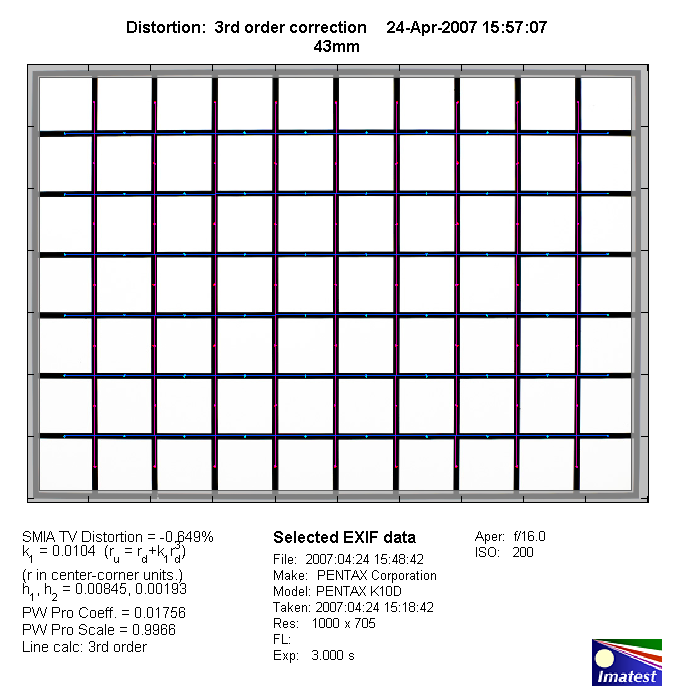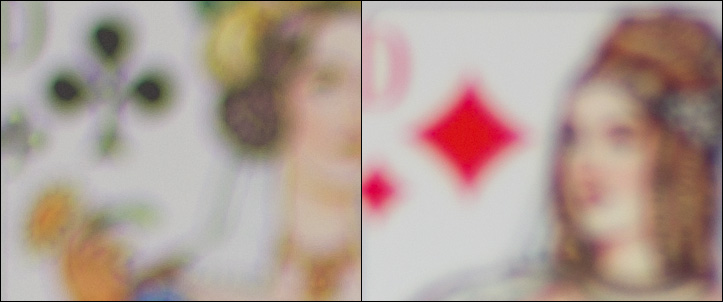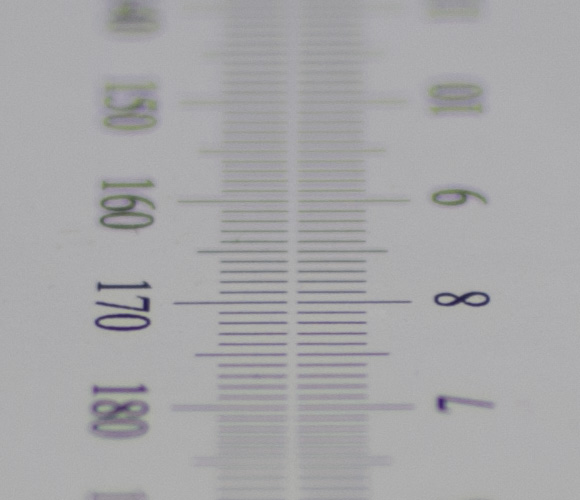|
Pentax SMC FA 43mm f/1.9 Limited - Lab Test / Review - Analysis |
|
Lens Reviews -
Pentax
|
|
Page 2 of 2

Distortion
Typical for standard/normal lenses the Pentax FA 43mm exhibits only a minor degree of barrel distortion (0.65%) - this is nothing to worry about.

Note: We have reused the results from the old review here - this characteristic cannot change by moving to a different camera of the same sensor format.
Vignetting
As a full format normal lens the 43mm f/1.9 enjoys a sweet spot advantage on the K5. Nonetheless it still produces slightly visible vignetting at f/1.9. However,
the issue is negligible from f/2.8 onwards.

MTF (resolution)
The results in the MTF lab were somewhat surprising. We expected a MTF curve more similar to the initial review but this sample didn't perform quite as good. The K10D and K5 have a very different AA filter characteristic which may explain at least part of the border results due to the way the resolution is measured here. FWIW, the tested sample had a very good centering which may also explain the slightly higher center contrast at f/1.9 compared to the old test.
Anyway, the center performance of the tested sample was very good at f/1.9. However, the border and corner quality is plain bad at this setting. Stopping down to f/2.8 lifts the center quality to excellent results and the border quality is at least acceptable whereas the corners remain very soft. The peak performance is reached between f/4 and f/5.6 with a good to very good quality in the outer image field. f/8 remains perfect usable although diffraction has a slight impact here in the image center. The field curvature (curved focus field) is a bit pronounced with this lens.
Please note that the MTF results are not directly comparable across the different systems!
Below is a simplified summary of the formal findings. The chart shows line widths per picture height (LW/PH) which can be taken as a measure for sharpness.
If you want to know more about the MTF50 figures you may check out the corresponding Imatest Explanations
Chromatic Aberrations (CAs)
Lateral chromatic aberrations (color shadows at harsh contrast transitions) are
relatively pronounced for a "normal" lens with an average CA pixel width around
1.4px on the average at the image borders. This is not a big deal but the
(younger) DA 40mm f/2.8 Limited did a better job here.

Bokeh
A very important aspect of an ultra-large aperture lens is the quality of the bokeh (rendering of the out-of-focus blur). It may be a little surprising but the Pentax lens didn't impress us here.
The foreground blur is very smooth - a rare characteristic here - whereas the more important background blur is more nervous.
 Out-of-focus highlights have an even inner zone but at f/1.9 there is a very pronounced outlining effect. This is substantially reduced at f/2.2 and gone by f/2.8. However, the highlight disc is only circular at f/1.9 - at least near the center portion of the image field. The 8-blade aperture shape is already visible from f/2.2 onward.
Out-of-focus highlights have an even inner zone but at f/1.9 there is a very pronounced outlining effect. This is substantially reduced at f/2.2 and gone by f/2.8. However, the highlight disc is only circular at f/1.9 - at least near the center portion of the image field. The 8-blade aperture shape is already visible from f/2.2 onward.

Bokeh Fringing / Longitudinal Chromatic Aberrations (LoCA)
Bokeh fringing is a common issue with fast glass. It's visible as halos of different colors in out-of-focus areas - magenta (red + blue) in front of the focus point and green beyond.
The 43mm f/1.9 shows noticeable bokeh fringing at large aperture settings which can be reduced by stopping down. The effect remains visible at f/2.2 and also f/2.8 but it is gone from f/4 onward.
|
Move the mouse cursor over the f-stop marks below to observe the respective LoCAs
|
| f/1.9 |
f/2.2 |
f/2.8 |
f/4 |
|

|
Verdict
The Pentax SMC FA 43mm f/1.9 Limited produced mixed feelings during the tests (performed at 16mp). This is in so far surprising that the lens performed rather nicely in our initial test based on the Pentax K10D (at 10mp). The center performance is impressive at max. aperture but the outer image region is plain soft here. The quality increases at f/2.8 but the peak performance is not reached prior of f/4 which is rather "late" for such a prime lens. Vignetting and distortions are well controlled whereas CAs could be a little lower for a fix-focal. The bokeh - the quality of the out-of-focus blur - did not impress during the first test nor during the more formal approach during the current lab sessions. This is somewhat disappointing. On the more positive side it is worth to mention the superb build quality of the lens. However, we have doubts whether the steep pricing is really justified regarding the total quality of the package.
| Optical Quality: |
 |
| Mechanical Quality: |  |
| Price/Performance: |  |
|